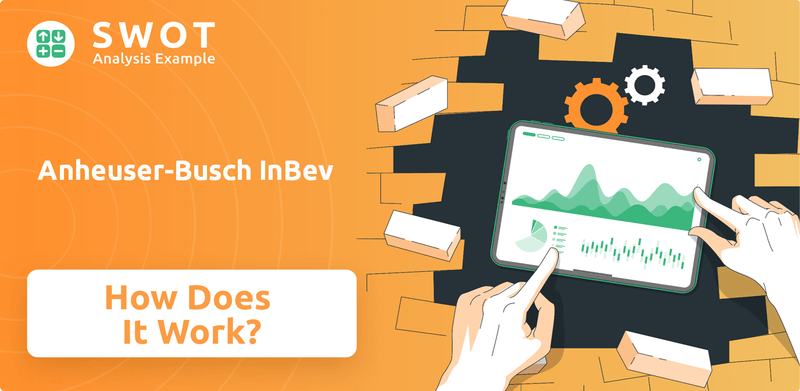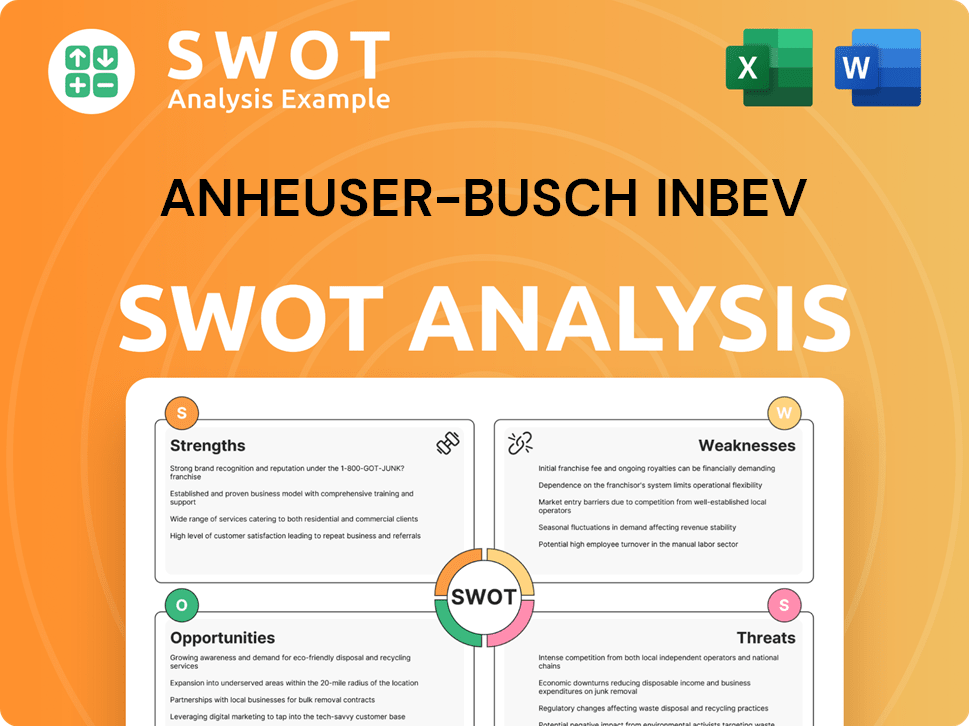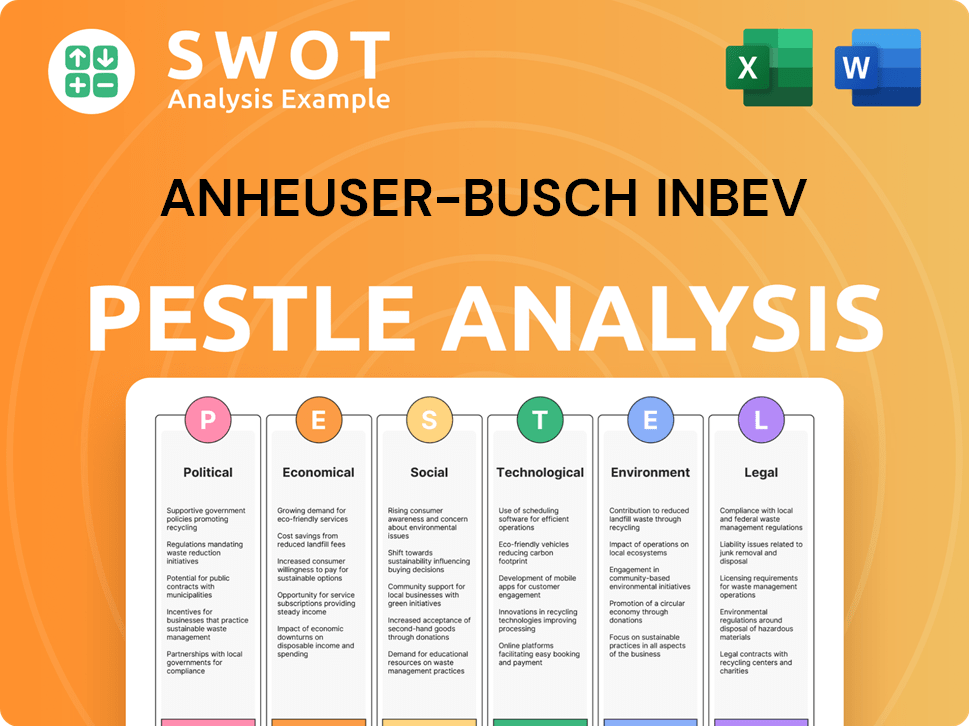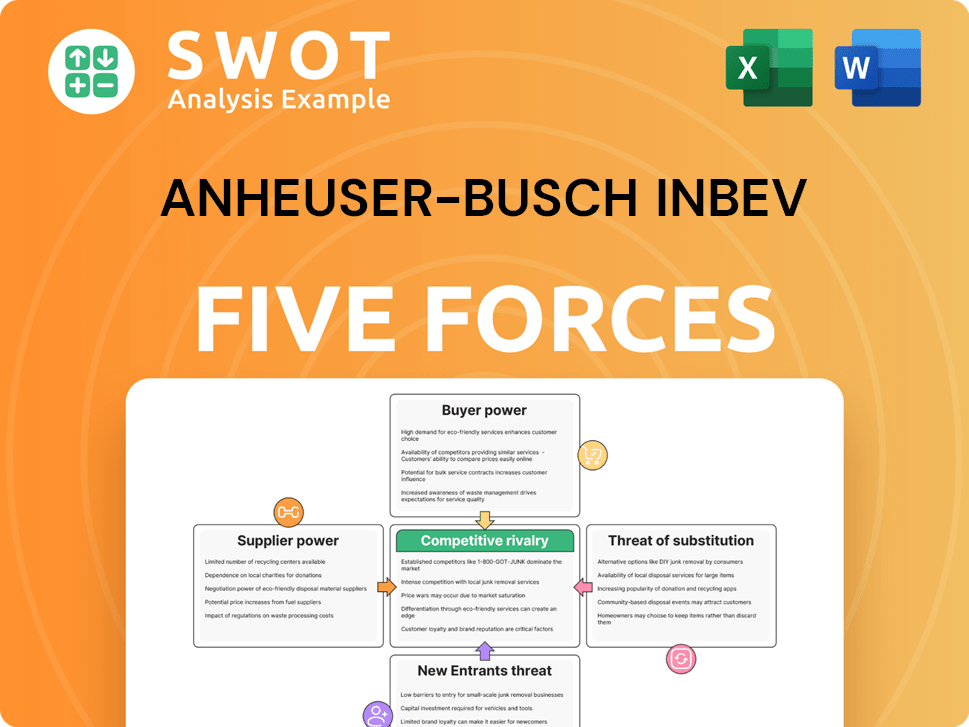Anheuser-Busch InBev Bundle
How Does Anheuser-Busch InBev Dominate the Beer Industry?
Anheuser-Busch InBev (AB InBev), the world's brewing behemoth, consistently shapes the global beverage landscape. With a staggering $59.8 billion in revenue reported in 2024, the AB InBev company showcases its financial prowess and market leadership, exceeding its 2023 performance. This multinational giant, based in Leuven, Belgium, boasts an impressive portfolio of over 630 beer brands, including iconic names like Budweiser and Corona, distributed across approximately 150 countries.

To truly understand AB InBev's success, one must examine its intricate operations, from brewery operations to its vast Anheuser-Busch InBev SWOT Analysis. The company's ability to navigate the competitive beer industry and global beer market, alongside its strategic acquisitions and robust distribution network, is key. This analysis will reveal how AB InBev generates profit and maintains its position as a global leader, offering valuable insights for investors and industry watchers alike, dissecting the AB InBev business model and its financial performance.
What Are the Key Operations Driving Anheuser-Busch InBev’s Success?
The core operations of the Anheuser-Busch InBev (AB InBev) company revolve around the creation and distribution of its extensive portfolio of beer and other beverage brands. This involves a comprehensive process that includes brewing, bottling, distribution, and marketing. The company's value proposition is centered on providing a wide variety of high-quality beverages to meet diverse consumer preferences worldwide, from premium lagers to craft beers and non-alcoholic options.
AB InBev's operational efficiency is significantly enhanced by its vertically integrated business model and its vast distribution network. This structure allows for stringent quality control and maximized efficiency across its global supply chain. The company's global footprint, with operations in over 50 countries and 260 breweries, provides economies of scale and access to diverse markets, enabling it to serve a global customer base effectively.
A key aspect of AB InBev's strategy involves strategic partnerships and digital transformation. The company collaborates with partners like PepsiCo to broaden its income channels and enhance its market presence. Furthermore, AB InBev has invested heavily in digital platforms to streamline operations and improve customer service, which has become a critical differentiator in the competitive beer industry.
AB InBev operates in over 50 countries, with 260 breweries worldwide. This extensive network supports its global distribution and market reach. This large-scale presence allows the company to efficiently manage its supply chain and cater to a diverse customer base.
The company offers a wide range of beverages, including premium lagers, craft beers, and non-alcoholic options. This diverse portfolio caters to various consumer preferences and market segments. The focus is on providing high-quality products that meet global demand.
AB InBev's distribution network reaches over 6 million customers globally. This extensive reach is a key factor in its market dominance. The company's ability to efficiently deliver its products worldwide is a significant competitive advantage.
AB InBev is committed to digital transformation, with its B2B platform, BEES, operational in 28 markets. BEES accounted for 75% of total revenue in 2024. The company also uses omnichannel direct-to-consumer platforms like Zé Delivery, TaDa Delivery, and PerfectDraft, which generated $1.4 billion in revenue in 2024.
AB InBev's commitment to digital transformation and innovation sets it apart in the Growth Strategy of Anheuser-Busch InBev. The B2B digital platform, BEES, streamlines ordering for retailers and provides marketing support, credit access, and business insights. The omnichannel direct-to-consumer (DTC) ecosystem, including platforms like Zé Delivery, TaDa Delivery, and PerfectDraft, enhances customer benefits through improved accessibility and service, differentiating it in the global beer market. These digital capabilities have significantly contributed to AB InBev's financial performance and market share.
AB InBev's operational effectiveness is driven by its global scale, efficient distribution, and digital innovation.
- Vertical integration and extensive distribution network reaching over 6 million customers.
- Strategic partnerships, such as with PepsiCo, to broaden market presence.
- B2B platform BEES, operational in 28 markets, accounted for 75% of total revenue in 2024.
- DTC platforms generated $1.4 billion in revenue in 2024, processing over 76 million e-commerce orders.
Anheuser-Busch InBev SWOT Analysis
- Complete SWOT Breakdown
- Fully Customizable
- Editable in Excel & Word
- Professional Formatting
- Investor-Ready Format

How Does Anheuser-Busch InBev Make Money?
The revenue streams and monetization strategies of Anheuser-Busch InBev (AB InBev) are diverse, focusing on both traditional sales and innovative digital platforms. The AB InBev company generates substantial revenue from its extensive portfolio of alcoholic and non-alcoholic beverages sold worldwide. The company's approach includes strategic initiatives to capitalize on market trends and consumer preferences.
AB InBev's primary revenue source is the sale of beer, encompassing a wide range of brands and styles. The company also leverages digital platforms and strategic partnerships to enhance its revenue streams and market reach. These strategies are crucial for maintaining its position in the competitive global beer market.
In 2024, AB InBev reported total revenue of $59.8 billion. Beer sales are the primary driver, including global megabrands like Budweiser, Corona, and Stella Artois. The above-core beer portfolio, including premium and super-premium brands, contributed 35% of total revenues in 2024. Non-alcoholic beer sales also showed strong growth, increasing by more than 20% in 2024.
AB InBev utilizes digital platforms to drive revenue. The BEES B2B e-commerce platform is a significant contributor.
In 2024, BEES captured $49 billion in Gross Merchandise Value (GMV), a 19% increase from 2023. The BEES Marketplace generated $2.5 billion in GMV in 2024, a 57% year-over-year growth.
DTC platforms like Zé Delivery, TaDa Delivery, and PerfectDraft contributed significantly. These platforms enhance customer relationships and create new revenue streams.
The DTC omnichannel ecosystem generated $1.4 billion in revenue in 2024.
AB InBev focuses on premium beer offerings to meet consumer preferences. Revenue per hectoliter grew by 4.3% in FY24.
Strategic alliances, such as bottling and distribution agreements with PepsiCo through Ambev, diversify income channels.
AB InBev's revenue model is supported by multiple factors, including a diverse brand portfolio and strategic market approaches. The company's operations are designed to adapt to changing consumer behaviors and market dynamics.
- Beer Sales: Core product offering with a wide range of brands.
- Premiumization: Focus on premium and super-premium brands.
- Digital Platforms: BEES B2B e-commerce and DTC channels.
- Strategic Alliances: Distribution agreements with partners like PepsiCo.
- Non-Alcoholic Beverages: Expansion into non-alcoholic options and energy drinks.
Anheuser-Busch InBev PESTLE Analysis
- Covers All 6 PESTLE Categories
- No Research Needed – Save Hours of Work
- Built by Experts, Trusted by Consultants
- Instant Download, Ready to Use
- 100% Editable, Fully Customizable

Which Strategic Decisions Have Shaped Anheuser-Busch InBev’s Business Model?
The journey of Anheuser-Busch InBev (AB InBev) has been marked by significant milestones and strategic moves that have shaped its operations and financial performance. The company's formation in 2008 through the merger of Interbrew and AmBev, followed by the acquisition of Anheuser-Busch, created the world's largest brewer. A pivotal strategic move was the acquisition of SABMiller in 2016, which further solidified its global market share.
In recent years, AB InBev has emphasized digital transformation, launching its B2B e-commerce platform, BEES, in 2019, which has become a major driver of revenue. The company has also faced operational and market challenges, including a soft consumer environment in China and Argentina in 2024, which contributed to a total volume decline of 1.4% for the year. Despite these headwinds, AB InBev has responded by focusing on premiumization and revenue management initiatives.
AB InBev's competitive advantages are multifaceted, stemming from its strong global presence, brand strength, and cost leadership. The company continues to adapt to new trends by investing in new technologies and capabilities, including significant investments in its production facilities. For a more detailed look at the company's origins, consider reading the Brief History of Anheuser-Busch InBev.
The merger of Interbrew and AmBev in 2008, followed by the acquisition of Anheuser-Busch, established AB InBev as the world's largest brewer. The acquisition of SABMiller in 2016 further strengthened its global position in the beer industry.
AB InBev launched its B2B e-commerce platform, BEES, in 2019, which has become a major revenue driver. The company focuses on premiumization and revenue management to offset market challenges. They are also expanding their 'Beyond Beer' portfolio.
AB InBev benefits from a strong global presence in the global beer market, with operations in over 50 countries and a portfolio of over 630 brands. The company's iconic brands like Budweiser, Corona, and Stella Artois foster high brand recognition. AB InBev maintains a cost leadership strategy through efficient production and supply chain systems.
In 2024, 75% of AB InBev's revenues were captured through its B2B digital platforms. Despite a 1.4% volume decline in FY24, revenue per hectoliter grew by 4.3%. The 'Beyond Beer' portfolio contributed 2% to total revenues in 2024.
AB InBev's competitive advantages are rooted in its global scale, brand power, and operational efficiency. These factors enable it to navigate the complexities of the beer industry and maintain a leading position in the global beer market.
- Global Presence: Operations in over 50 countries and a portfolio of over 630 brands.
- Brand Strength: Iconic brands like Budweiser, Corona, and Stella Artois.
- Cost Leadership: Efficient production and supply chain systems.
- Sustainability: Commitment to reducing carbon emissions and using renewable energy.
- Digital Transformation: Investment in platforms like BEES.
Anheuser-Busch InBev Business Model Canvas
- Complete 9-Block Business Model Canvas
- Effortlessly Communicate Your Business Strategy
- Investor-Ready BMC Format
- 100% Editable and Customizable
- Clear and Structured Layout

How Is Anheuser-Busch InBev Positioning Itself for Continued Success?
Anheuser-Busch InBev (AB InBev) holds a leading position in the global beer market. As the world's largest brewer, the AB InBev company had an estimated global market share of 28% as of 2023. This dominance is supported by a diverse brand portfolio and a vast distribution network, fostering strong customer loyalty across various regions.
Despite its robust market position, AB InBev faces several challenges. These include heightened competition from other major players in the beer industry, evolving consumer preferences towards alternative beverages, and the impacts of regulatory changes and geopolitical factors. The company must also manage elevated costs related to commodity price inflation and supply chain expenses.
AB InBev is the world's largest brewer with a significant presence in the global beer market. Its extensive brand portfolio and global distribution network reinforce its market leadership. The company's ability to adapt to changing consumer preferences and maintain financial discipline is crucial.
Key risks include competition from major breweries, evolving consumer preferences, and regulatory changes. Elevated costs from commodity price inflation and supply chain expenses also pose challenges. These factors can impact AB InBev's profitability and operational efficiency.
AB InBev is focusing on strategic initiatives to sustain and expand its profitability. The company anticipates EBITDA growth between 4-8% in 2025. Key strategies include investments in premium products and digital transformation.
AB InBev is committed to achieving net zero emissions by 2040 and using 100% renewable electricity by 2025. The company plans net capital expenditure of between $3.5 billion and $4.0 billion in FY25. These efforts are vital for long-term growth.
AB InBev is focused on several key strategies to drive future growth and maintain its market leadership. These include a continued emphasis on premium products, further digital transformation, and ongoing business optimization efforts to improve efficiency. These initiatives are designed to ensure the company’s long-term success in the dynamic beverage industry.
- Continued investment in premium products.
- Further digital transformation of its ecosystem.
- Ongoing business optimization to improve efficiency.
- Net capital expenditure between $3.5 billion and $4.0 billion in FY25.
For more insights into the ownership structure and stakeholders, explore Owners & Shareholders of Anheuser-Busch InBev.
Anheuser-Busch InBev Porter's Five Forces Analysis
- Covers All 5 Competitive Forces in Detail
- Structured for Consultants, Students, and Founders
- 100% Editable in Microsoft Word & Excel
- Instant Digital Download – Use Immediately
- Compatible with Mac & PC – Fully Unlocked

Related Blogs
- What are Mission Vision & Core Values of Anheuser-Busch InBev Company?
- What is Competitive Landscape of Anheuser-Busch InBev Company?
- What is Growth Strategy and Future Prospects of Anheuser-Busch InBev Company?
- What is Sales and Marketing Strategy of Anheuser-Busch InBev Company?
- What is Brief History of Anheuser-Busch InBev Company?
- Who Owns Anheuser-Busch InBev Company?
- What is Customer Demographics and Target Market of Anheuser-Busch InBev Company?
Disclaimer
All information, articles, and product details provided on this website are for general informational and educational purposes only. We do not claim any ownership over, nor do we intend to infringe upon, any trademarks, copyrights, logos, brand names, or other intellectual property mentioned or depicted on this site. Such intellectual property remains the property of its respective owners, and any references here are made solely for identification or informational purposes, without implying any affiliation, endorsement, or partnership.
We make no representations or warranties, express or implied, regarding the accuracy, completeness, or suitability of any content or products presented. Nothing on this website should be construed as legal, tax, investment, financial, medical, or other professional advice. In addition, no part of this site—including articles or product references—constitutes a solicitation, recommendation, endorsement, advertisement, or offer to buy or sell any securities, franchises, or other financial instruments, particularly in jurisdictions where such activity would be unlawful.
All content is of a general nature and may not address the specific circumstances of any individual or entity. It is not a substitute for professional advice or services. Any actions you take based on the information provided here are strictly at your own risk. You accept full responsibility for any decisions or outcomes arising from your use of this website and agree to release us from any liability in connection with your use of, or reliance upon, the content or products found herein.